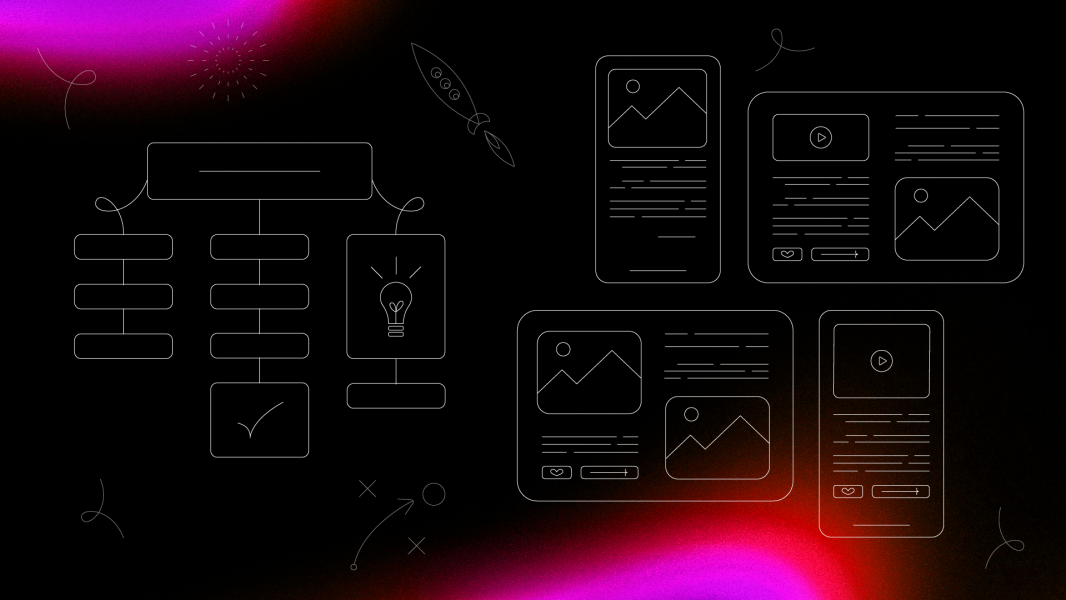The importance of collaborative sitemapping and wireframing in website design.
Topic
Website Design5 mins read

When it comes to website design, the foundation of a successful project is laid early on during the sitemapping and wireframing stages. They’re not the sexiest or most exciting, but these phases form the blueprint for the structure, navigation and overall functionality of a website, making them crucial to the entire design and development process that follows.
As a website design agency with more site launches under our belt than we dare to count, we’ve seen firsthand how missteps or a lack of collaboration during these stages can lead to tricky headaches later. Miscommunication, unmet expectations and unnecessary rework are just a few of the pitfalls that arise when clients aren’t involved early and consistently in the process.
By holding collaborative sitemapping and wireframing workshops, agencies and clients can work together to define clear objectives, ensure mutual understanding and set the stage for a smooth design process. Who wouldn’t want that?
Let’s take a deeper look at how early collaboration prevents pitfalls and share some practical tips on how to run productive workshops.
The crucial need for early client collaboration.
At its core, sitemapping involves organising the website’s structure, determining what pages are needed and mapping out the user journey. Wireframing, on the other hand, provides a visual guide that outlines the page layout, including elements such as buttons, navigation and content hierarchy. Both steps are foundational to a well-functioning website, but without client input, the results can quickly miss the mark.
In our experience, involving clients early in these stages delivers three key benefits:
- Clarity of goals: Early collaboration ensures that both the agency and client are on the same page regarding business objectives, user expectations and design preferences.
- Preventing misalignment: When clients aren’t involved in the sitemapping and wireframing process, the risk of creating a site that doesn’t meet their vision or needs increases. Early collaboration minimises these risks and allows for course corrections before the project advances too far.
- Saving time and resources: By identifying potential issues upfront, agencies can avoid costly revisions or complete redesigns further into the development phase.
Common pitfalls when client collaboration is overlooked.
Failing to engage clients early in the sitemapping and wireframing process can lead to a host of problems, many of which can stall the entire project. Here are a few of the most common issues we’ve seen and heard of:
- Miscommunication of business needs: If clients are not deeply involved from the outset, agencies might misinterpret or overlook essential business requirements. For instance, critical pages may be omitted from the sitemap or the wireframe may not properly prioritise the content most important to the client.
- Unmet user expectations: Clients know their target audience better than anyone. Without their insights during the sitemapping stage, agencies might design a website that lacks the right user flow, leading to a poor user experience. This is especially problematic in sectors like e-commerce or service-based businesses, where user journeys are critical to conversions.
- Endless revisions: The further a project progresses without client feedback, the more difficult (and expensive) it becomes to make changes. This can lead to endless revisions, where the design is constantly tweaked to match the client’s vision, something that could have been avoided with early collaboration.
Running productive sitemapping and wireframing workshops.
To avoid these pitfalls, we believe it’s crucial to engage clients right from the start. One of the most effective ways to do this is by conducting sitemapping and wireframing workshops. These workshops allow the agency and client teams to collaborate in real-time, ensuring that both parties are aligned on the structure, design and functionality of the website.
Here are some tips based on industry best practices and our own experience as a website design agency on how to run productive (and fun!) workshops:
- Set clear objectives for the workshop
-
- Before the workshop begins, outline clear goals. Are you trying to define the structure of the website, identify user personas, or simply brainstorm design ideas? Clear objectives will guide the session and prevent it from going off-track.
- Involve key stakeholders
-
- Ensure that the right people are in the room. On the client’s side, this might include marketing managers, department heads or customer service teams who can offer valuable insights into the website’s target audience and user needs. On the agency’s side, we like to have our UX designers, copywriters and project managers in the room to help translate those insights into actionable designs.
- Use collaborative tools
-
- Leverage digital tools that encourage real-time collaboration. We like to use platforms like Figma (especially FigJams!) to help visualise ideas and ensure everyone is aligned. These tools are especially useful for remote or hybrid workshops, allowing all participants to contribute to sitemaps and wireframes simultaneously.
- Break down the process
-
- Start by developing the sitemap. Map out the primary and secondary navigation, focusing on user paths and key content areas. Once the sitemap is approved, move on to wireframing. Here, work together to outline page layouts, starting with key pages like the home page, product pages or service pages.
- Encourage open feedback
-
- A productive workshop is one where both parties feel comfortable offering feedback. We encourage our clients to ask questions, express concerns and make suggestions. This open dialogue is crucial for avoiding misunderstandings and ensuring that the final design aligns with their vision.
- Document everything!
-
- Finally, be sure to document the outcomes of the workshop. This includes final decisions on sitemaps, wireframes and any action items for both the agency and client. Having a clear record of decisions prevents confusion later and keeps the project moving forward smoothly. We love to use AI notetaking tools such as Fireflies to make life a lot easier.
Involving clients early in the website design process, particularly during sitemapping and wireframing, is key to avoiding costly mistakes and ensuring a successful end product. By running collaborative workshops and keeping communication open throughout these early stages, agencies like us can create websites that not only meet their clients’ needs but also deliver a seamless user experience.
As a website design agency, we’ve found that this approach not only saves time and resources but also strengthens our relationships with clients, fostering trust and shared ownership over the project. Early collaboration isn’t just beneficial, it’s essential for building a website that truly works.
If you’re looking for a website design agency to take your new or existing website to the next level, let’s talk.

